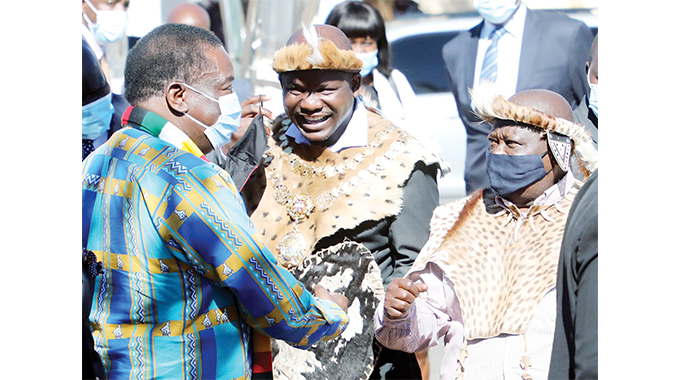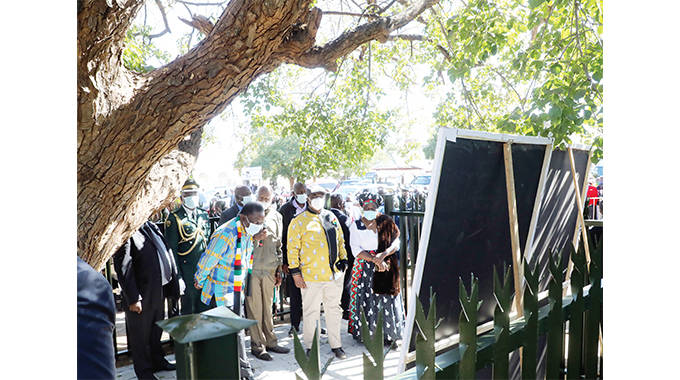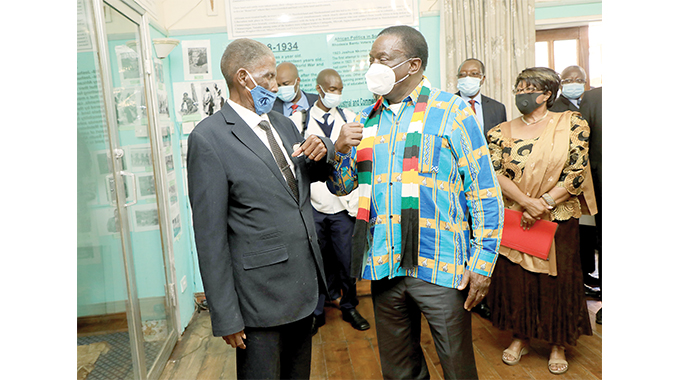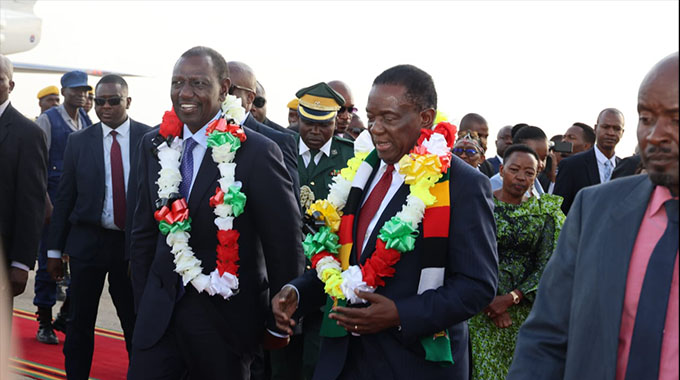Hanging Tree evokes ED death escape

Nduduzo Tshuma, Assistant Editor
PRESIDENT Mnangagwa yesterday reflected on the brutality of the settler regime, which punished sons and daughters of the land seeking freedom with all forms of cruelty including hanging, a sentence he himself survived by a whisker.
The President was in Bulawayo to tour the Heritage Corridor in the morning and launch the Bulawayo Urban Heritage, Ecotourism and Arts Festival.
He kicked off his tour by visiting the Inxwala Grounds, where King Lobengula conducted important ceremonies before he was taken to The Hanging Tree, metres from the grounds.

Bulawayo Archbishop Alex Thomas details the history of the Roman Catholic St Mary’s Cathedral Basilica to President Mnangagwa yesterday
It was at The Hanging Tree that the tour guide and historian Mr Pathisa Nyathi narrated to the President how nine Ndebele warriors were in 1896 hanged by colonialists thereby crushing Imfazo 2 or Umvukela to resist colonial occupation.
The Ndebele warriors had, Mr Nyathi said, surrounded the colonialists in the present-day City Hall but the tide changed when reinforcements arrived from England.
Some of the warriors were captured and jailed at Grey Street Prison — now Bulawayo Prison — before they were taken to the hanging tree a few metres from the Inxwala Grounds, as a move to desecrate the place.
Years later during the struggle for Independence, Bulawayo Prison located four streets from the Hanging Tree at JMN Street, was “home” to President Mnangagwa.
He had been arrested in 1964 after he and his Crocodile Gang blew up a train at Fort Victoria, present day Masvingo.
He survived the hangman’s noose because of young age as he was 18, three years shy of the age at which one could have capital punishment executed on them.
His colleagues Victor Mlambo and James Dlamini who were older, were hanged.
He then spent 10 years in Khami Prison some 27 kilometres from where the Hanging Tree he visited yesterday stands.
After his release from Khami Prison in 1972, he was detained at Bulawayo Prison and then transferred to Hwange Prison before he was taken to Victoria Falls and deported into Zambia.
Later in the day as he launched the festival, the President who unveiled the statue of Mbuya Nehanda, also hanged by the colonialists in 1898 for challenging colonial dispossession, on Africa Day, said the Hanging Tree stands as a reminder of the savagery of imperialists to the country’s forebears.
“Lest we forget, The Hanging Tree stands as a reminder to present and future generations of the brutality and savagery of the white settler regime towards our forefathers. This national monument must inspire all of us and the youth in particular to consistently defend our Independence, territorial integrity and dignity as a nation,” he said.
“The re-incarnation of colonialism and imperialism in whatever form must never be allowed a foothold in our country.”
President Mnangagwa said Government made a bold and deliberate decision to correctly portray and promote the country’s rich and cultural heritage.
“To this there is no going back,” he declared.
Mr Nyathi said the Ndebele warriors waged a war against white settlers to the point of almost handing them a defeat.
“In 1896, that was the time of Imfazo 2, the first resistance to white penetration was in 1893. The Ndebele then decided they were going to fight to resuscitate their lost freedom, their lost ownership of the land,” he told President Mnangagwa who was accompanied by his deputy Dr Constantino Chiwenga and several ministers.
“In 1896 the whites were surrounded in the area covering present day City Hall until they were rescued by reinforcements from England.
“They were capturing some of the soldiers who were fighting and brought them here to hang them from this tree and this is the only indigenous tree in the central business district of Bulawayo, we call it Umganunkomo (False Marula) tree,” said Mr Nyathi.

President Mnangagwa, Vice-President Constantino Chiwenga and Minister of State for Bulawayo Provincial Affairs and Devolution Cde Judith Ncube are taken on a tour of the Hanging Tree by historian Pathisa Nyathi during a tour of the Heritage Corridor. (Picture Eliah Saushoma)
“We are told about 9 people were hanged from here by Baden Powell the man who started the boy scout movement which spread to many other parts of the world.”
Mr Nyathi said the tree symbolises determination to resist colonial penetration.
“It ought to be a place of honour that we dedicate ourselves that never again should such things happen,” he said.
Mr Nyathi explained that the Ndebele warriors were imprisoned at Grey Street Prison, before they were hanged to which the President exclaimed, “Ah I was also detained at Grey Street Prison.”
Mr Nyathi called for historical narratives to accompany the historical sites for the benefit of the future generations.
At the Inxwala Grounds, Mr Nyathi said of the place:
“Inxwala means something that is taboo, something that is sacred. It refers to national song which was sung here, sung once and never again until the following year at the same time. That was what was known as Inxwala which wrapped several things into one. It had cultural dimensions, it had spiritual dimensions, political dimensions, everything wrapped into one,” said Mr Nyathi.
“As was the tradition among the Nguni, there was Inxwala every year and it was a time for regeneration, rejuvenation, when they were appealing to God to give blessings to the nation, to the King. The King was the State, the State was the King so when you strengthen the King, by extension you are strengthening the nation.”
He said it was also used for thanksgiving, paying tribute to God for the good harvests among other activities.
The President said the visit to the Inxwala Grounds was opportune following the successful agricultural season.
“The sojourn to the site retraces King Lobengula’s footprints to the sacred shrine where the harvest celebrations and other important ceremonies in the Ndebele culture were conducted,” he said.
President Mnangagwa then moved to the statue of veteran nationalist and the late former Vice President Dr Joshua Nkomo at the intersection of JMN Street and 8th Avenue.
The statue stands on the very spot where colonialist Cecil John Rhode’s statue once stood and was removed after Independence.
“The statue and Memorial Museum of the late National Hero, uMdala Wethu and Founding Father Comrade, Dr Joshua Mqabuko Nyongolo Nkomo, Chibwe Chitedza evokes sentiments of the importance of unflinching patriotism and loyalty as well as peace and unity to the achievement of sustainable development,” said the President later.

President Mnangagwa watches a performance at the Joshua Mqabuko Nkomo Statue in Bulawayo
He also visited the St Mary’s Cathedral Basilica Parish, Joshua Nkomo Memorial Museum and the Natural History Museum.
“The Natural History Museum and the St Mary’s Cathedral Basilica Parish, among other sites demonstrate the wealth and diversity of our culture and heritage. These must be cherished protected and safeguarded for generations to come,” he said.










Comments